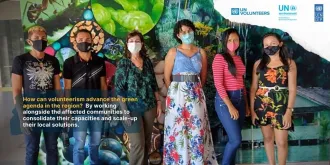Climate change is a global challenge. However, when combined with other variables such as age, gender, ethnicity or social class, its impacts are greater. With volunteerism, we can empower affected people to build resilient communities on the road to the year 2030.
According to the State of the Climate in Latin America and the Caribbean 2020 Report, more than 312,000 people lost their lives and 277 million were affected by climate-related events between 1998 and 2020; the severe droughts in the southern Amazon were the worst in 50 years, while in Central America, a record of 30 storms a year was recorded with 8 million people affected. In Guatemala and Mexico, 50% to 80% of crops have been lost, affecting the population's food security during 2020.
In this context, limiting global temperature rises to 1.5°C is a key to avoiding significant environmental impacts. However, according to a UNDP report, almost 50% of the major greenhouse gas emitting countries showed no progress in reductions.
Rising temperatures are a problem for human welfare, especially in Latin America, where it's hot and humid. It also affects the rivers where the water level is very low. It causes fish to migrate and endangers the ecological balance and food security," --Danielle Rodrigues, UN Volunteer Local Technician for the project at Bem Diverso of UNDP Brazil
Then how can we contribute to reducing the impact of climate change through volunteering?
One possible strategy is to work with the communities who were affected to strengthen their local capacities.
"In Alto do Rio Pardo, we generate opportunities for dialogue with the affected population to determine what we can do for environmental restoration. We opted for direct planting and there are already positive results," says Cleidiana Agostinho, a UN Volunteer serving as a Local Technician for Bem Diverso in the State of Minas Gerais, where eucalyptus monoculture has left some communities without drinking water [1].
The promise of "Leaving no one behind" also implies that the communities themselves are the leaders of their agendas. "We provide training on good hygiene practices for handling the pulp of the açaí fruit, the community's main source of income, which helps prevent diseases such as Chagas disease. In addition, together with local artisans, we develop kits that we then distribute at an affordable price," explains Danielle Rodrigues, UN Volunteer serving as Local Technician for the project at Bem Diverso of UNDP Brazil.
On the other hand, for these community solutions to become sustainable, collective efforts with the State are necessary. "We work together with government representatives, holding workshops, preparing specialized documents, as well as organizing dialogues with experts, social organizations and community leaders," says Astrid Sotomayor, UN Volunteer serving as Environmental Data Analyst for the UN Environment Programme's (UNEP) Global Peatlands Initiative in Peru [2].
With the information and alliances generated, it's possible to develop cross-cutting, comprehensive public policies based on scientific evidence,” --Astrid Sotomayor, UN Volunteer Environmental Data Analyst for UNEP Global Peatlands Initiative in Peru
Lastly, working with young people is the key to the green agenda. "My message to world leaders is to listen to and work with youth. We are very close to having a point of no return, and they are the ones who have the motivation to carry the intergenerational messages forward," says Astrid. "Young people are the leaders of the future. They are full of ideas to make their communities stronger and more productive," says Danielle.
Volunteering is a mechanism that articulates the different actors in society to strengthen the solutions that are already being implemented in Latin American and Caribbean communities and empower them with inclusive and participatory public policies.
[1] Eucalyptus is a tree plant widely used for cellulose production and wood exploration.
[2] Peatlands are a type of wetland that has the capacity to store large amounts of carbon.
This article was written with the kind support of Online Volunteer, Thalita Lima, and translated by Online Volunteer María Florencia Guzmán.

